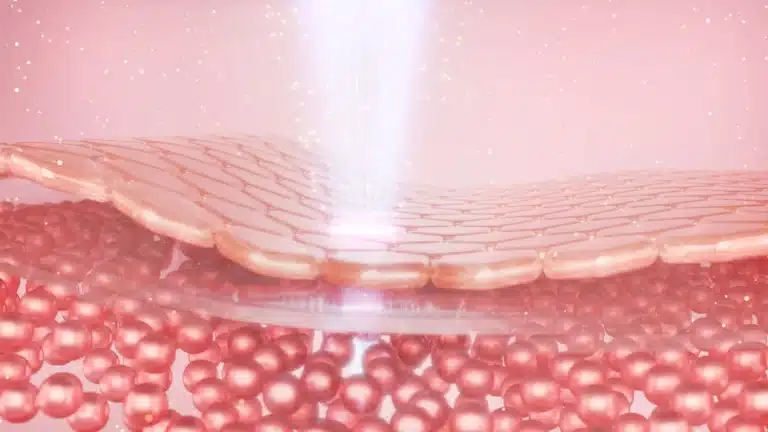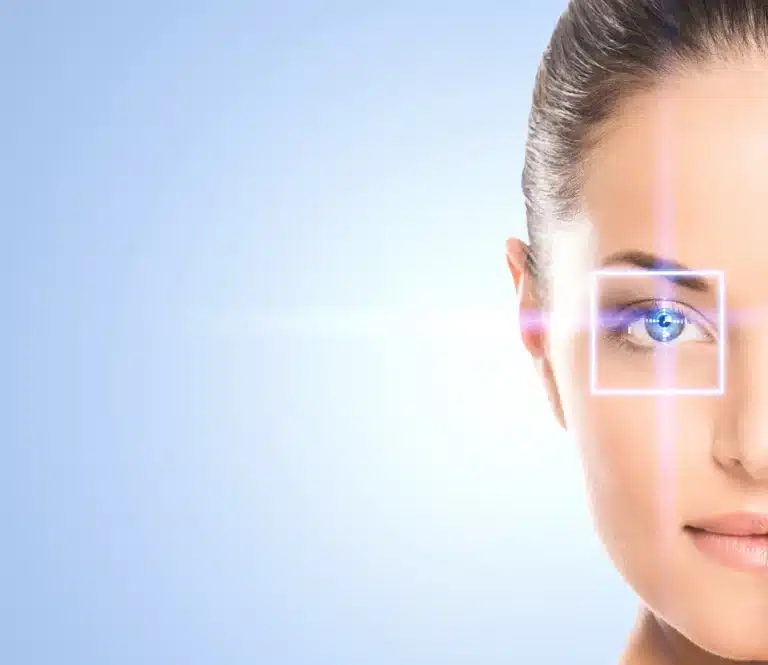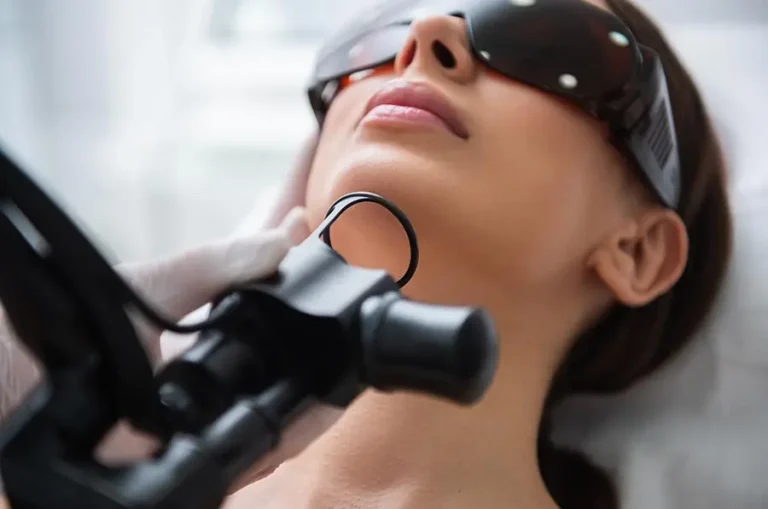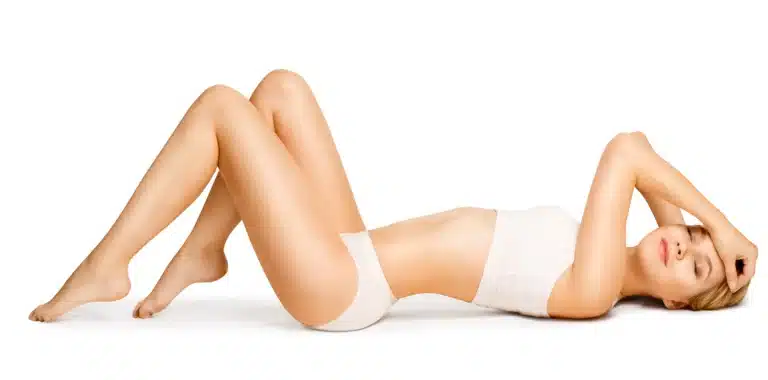Home » Solutions » Lasers and devices » Photorejuvenation
Laser skin rejuvenation is a technique that aims to improve the appearance and texture of the skin by stimulating collagen production. Unlike ablative lasers that remove superficial skin layers, non-ablative lasers work deeper in the skin while leaving the surface intact.
Laser rejuvenation is a non-invasive solution that delivers visible results without social downtime. This method is gentle yet effective for rejuvenating the skin and preventing the signs of aging.
Le photorajeunissement laser est une technique de médecine esthétique qui permet de stimuler la production de collagène et d’améliorer la qualité de la peau sans éviction sociale. Ce traitement utilise des lasers non ablatifs, notamment le laser erbium non ablatif, pour pénétrer en profondeur dans les
couches de la peau sans altérer la surface. Cela en fait une méthode idéale pour les patients souhaitant traiter les signes de l’âge tout et reprendre immédiatement leurs activités.

The principle of laser skin rejuvenation is to use light energy to penetrate deep into the skin.
The heat generated by the light stimulates collagen production and promotes cell renewal.
The goal is to activate the deeper layers of the skin without affecting the surface. Patients can benefit from rejuvenating effects without any downtime : after treatment, there is no redness or peeling.
However, if agreed with the patient, Doctor Romano may use higher settings, which can lead to temporary intense redness lasting two days.
Laser rejuvenation is suitable for patients looking to treat signs of skin aging. It is an anti-aging treatment without downtime.
This method is particularly effective for :
• Firming the skin.
• Reducing fine lines and wrinkles.
• Treating pigment spots and sun damage.
• Improving skin texture and evening out skin tone.
Any part of the body can be treated, but the procedure is most commonly performed on the face, neck, décolleté, and hands.

The non-ablative erbium laser is considered the most effective device for laser skin rejuvenation. Compared to other lasers or technologies such as IPL, radiofrequency or the Nd:YAG laser, the erbium laser works deeper and more intensively to stimulate collagen production. It delivers long-lasting results, with visible improvement in skin quality after just one session.
While several types of lasers can be used for rejuvenation, the non-ablative erbium laser stands out for its depth of action and effectiveness. Other technologies — including the Nd:YAG laser, Erbium Glass, radiofrequency , or IPL — can also stimulate the skin, but their results are generally less significant and less long-lasting.
Comparison with Nd:YAG laser : the Nd:YAG laser is often used to treat vascular issues or to tighten pores. However, its collagen-stimulating effects are less significant. Its action is shallower, as the light beam does not penetrate as deeply into the skin.
Comparison with IPL : IPL (intense pulsed light) is another technique used for skin rejuvenation, but it mainly targets the surface of the skin. While effective for reducing pigmentation spots and brightening the complexion, it has only mild effects on firmness and skin texture.

Although laser rejuvenation is a non-invasive and safe procedure, there are some conditions that may prevent treatment.
• Epilepsy : the laser light could trigger a seizure.
• Skin disorders on the treatment area : inflammatory or infectious lesions.
• Pregnancy : not recommended as a precaution.
• Very sensitive or highly reactive skin.
• Use of photosensitising medications : these increase the risk of burns.
• History of keloid or hypertrophic scarring.
• Autoimmune diseases that affect the skin or impair healing.
• Recent sun exposure : treatment should not be performed on tanned skin due to the high risk of burns.
• History of skin cancer in the treatment area.
• Skin exfoliation in the past 3 weeks : chemical (peels, retinol-based creams, fruit acids, topical acne products) or mechanical.
• Conditions impairing healing, such as diabetes.

The laser skin rejuvenation session is preceded by an initial consultation to assess the areas to be treated, understand the desired result, and determine the most suitable laser settings based on the patient’s skin type and needs.
The session usually begins with a gentle cleansing of the skin to remove any impurities and ensure optimal and safe light penetration.
Once the eyes are protected with goggles, the treatment begins. The laser beam is passed over the entire area to be treated. The session is painless but may cause mild discomfort, as the patient feels a sensation of warmth.
The procedure lasts around ten minutes, depending on the size of the treatment area. Normal daily activities can be resumed immediately after the session.
Before undergoing a laser skin rejuvenation treatment, certain precautions must be taken.
It is recommended to avoid any sun exposure (including tanning beds) during the 3 weeks prior to the session, as the skin must not be tanned to prevent the risk of burns or depigmentation.
It is also advisable to stop using products containing retinoids or exfoliating acids a few days before the treatment to avoid sensitising the skin.
Lastly, you must inform your doctor of any medication you are currently taking, as some may contain photosensitising compounds.
After a laser skin rejuvenation session, it is essential to follow specific guidelines to protect the skin and avoid complications. Direct sun exposure must be avoided for at least 2 weeks, and a high-SPF sunscreen (SPF 50+) should be applied regularly. It is also advisable to keep the skin well hydrated using gentle, non-irritating products to support the healing process. In the days following the treatment, saunas, hot baths and any activity that causes excessive sweating should be avoided, as they could irritate the skin. Lastly, aggressive products (chemical exfoliants, retinol, acne creams) should not be used for the three weeks following the session.

Le nombre de séances nécessaires dépend de l’état initial de la peau et des résultats souhaités. En général, 2 à 3 séances espacées de 6 semaines sont recommandées pour obtenir des résultats visibles et durables. Toutefois, une amélioration de la texture et de la fermeté de la peau est visible dès la première séance, les résultats optimaux sont obtenus 3 mois après chaque séance.
• Long-lasting results : deep collagen stimulation ensures that improvements persist over time.
• No downtime : the treatment is non-invasive, allowing patients to resume their daily activities immediately without any visible side effects.
• Gradual improvement : results continue to improve over time, as collagen production progresses. Optimal results are achieved around three months after the session.
Laser rejuvenation delivers visible improvements while remaining a gentle treatment.
The benefits for the skin include :
• Improved skin elasticity : laser energy stimulates collagen production, which enhances elasticity and reduces signs of skin laxity.
• Reduction of wrinkles and fine lines : by densifying the dermis, the treatment visibly smooths the skin and reduces superficial wrinkles.
• More even skin tone : pigmentation irregularities and brown spots are reduced, leading to a more uniform and radiant complexion.
• Smoother and firmer skin : the synthesis of new collagen results in firmer, denser skin with a more refined texture.
The price of a laser photorejuvenation session in Geneva is around 500 CHF. This rate corresponds to a session performed by a physician using state-of-the-art equipment, aimed at improving overall skin quality, reducing fine lines, and smoothing skin texture irregularities. The cost may vary depending on the type of laser used, the number of sessions required, or the specific needs identified during the consultation.
A personalized quote is systematically provided during the initial consultation.
The price of a photorejuvenation treatment reflects the quality of the equipment used, the safety of the medical setting, and the physician's expertise.
Yes, photorejuvenation is a non-invasive technique that improves skin texture, reduces pigmentation spots, and softens fine lines by stimulating collagen production.
Il est généralement déconseillé de pratiquer le photorajeunissement en été en raison de l’exposition accrue au soleil, qui peut augmenter le risque de complications comme les hyperpigmentations.
Photorejuvenation is mainly recommended for skin phototypes I to IV. Tanned or very dark skin may carry a higher risk of pigmentation disorders
Il n’y a pas d’âge spécifique pour débuter le photorajeunissement. Cependant, il est généralement envisagé à partir de 30 ans, lorsque les premiers signes du vieillissement cutané apparaissent.
Le photorajeunissement peut atténuer l’apparence des cicatrices superficielles, notamment celles causées par l’acné, en stimulant la production de collagène.
Le photorajeunissement utilise la lumière intense pulsée (IPL) pour traiter plusieurs imperfections simultanément, tandis que d’autres lasers sont plus spécifiques et souvent plus invasifs, nécessitant une période de récupération plus longue.
Yes, photorejuvenation is effective on areas such as the hands and décolleté, helping to reduce pigmentation spots and improve skin texture.